高中英语语法——倒装句复习总结
高中英语语法倒装句总结讲解

高中英语语法倒装句总结讲解1. 完全倒装:即将谓语动词的全部置于主语之前。
常见用法:1) 当here, there, in, ou t, up, down, on 等副词置于句首,且主语为名词时;2) 将表示地点、方位的介词短语置于句首;3) 直接引语置于句首,其后的主语是名词时。
2. 部分倒装:即将谓语动词的一部分置于主语之前(如助动词be, do, have, will,和情态动词may, can, must, should 等)。
常见用法:1) 否定词或词组,如neither, nor, never, nowhere, not, seldom, rarely, scarcely, barely, hardly, no sooner, at no time, in no case, in no way, by no means, on no condition 等置于句首时;2) so 表示“也”,neither/ nor表示“也不”;so / such… that 表示“那样……以至于”置于句首时;3) only + 状语/ 状从,置于句首时, 主句要部分倒装;注意:当only + 主语置于句首时,则用正常语序。
4) not only … but also…引导两个分句时,not only 引导的分句要部分倒装;5) not until + 状语/ 状从,“直到……才”,置于句首时,主句要部分倒装;6) adj. / adv. / n. / v. / 分词+ as / though + 主语+ 谓语:引导让步状从,置于句首时;7) 在虚拟语气的条件句中,如含should, had, were, 可将它们置于句首,且省略if;8) 用于:May + 主语+ v. 结构中,表示“祝愿”;9) 表示次数、频率的副词置于句首时(也可用正常语序)。
倒装句口诀:副词开头要例装,人称代词则如常。
only修饰副介状,位于句首半倒装。
高中英语知识点归纳倒装句的特殊情况和用法
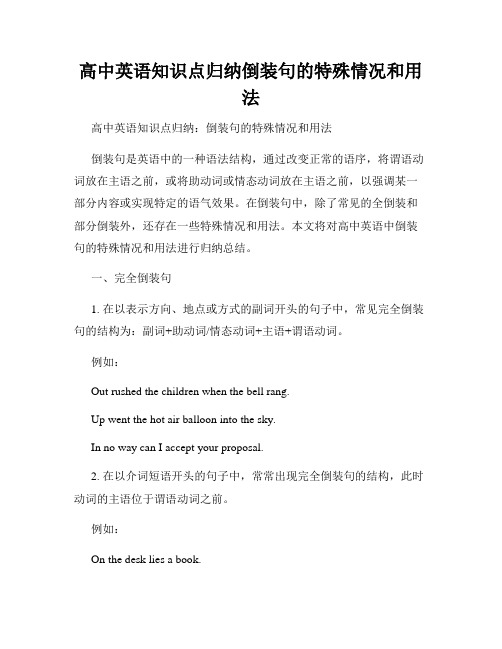
高中英语知识点归纳倒装句的特殊情况和用法高中英语知识点归纳:倒装句的特殊情况和用法倒装句是英语中的一种语法结构,通过改变正常的语序,将谓语动词放在主语之前,或将助动词或情态动词放在主语之前,以强调某一部分内容或实现特定的语气效果。
在倒装句中,除了常见的全倒装和部分倒装外,还存在一些特殊情况和用法。
本文将对高中英语中倒装句的特殊情况和用法进行归纳总结。
一、完全倒装句1. 在以表示方向、地点或方式的副词开头的句子中,常见完全倒装句的结构为:副词+助动词/情态动词+主语+谓语动词。
例如:Out rushed the children when the bell rang.Up went the hot air balloon into the sky.In no way can I accept your proposal.2. 在以介词短语开头的句子中,常常出现完全倒装句的结构,此时动词的主语位于谓语动词之前。
例如:On the desk lies a book.Under the bridge flows a river.二、强调句型倒装句常用于强调句型,通过改变正常语序,将被强调的部分提前至句首,以突出重要信息。
1. It is/was + 被强调部分 + that/who + 句子其余部分。
用于强调句子的主语、宾语、地点、时间等。
例如:It is Jane who won the singing competition.It was at the park where they met for the first time.It was yesterday that I finished reading the book.2. What/How + be 动词 + 主语 + 谓语动词 + 其他成分。
用于强调句子的母语、宾语、状语等。
例如:What I want is a peaceful world.How beautiful the sunset is!How hard he works!三、倒装句用于祝愿句和条件句1. May/Should + 主语 + 谓语动词.May you have a wonderful journey!Should you need any assistance, feel free to contact us.2. If + should/ were + 主语 + 谓语动词.If it should rain tomorrow, we will cancel the outdoor activity.If I were you, I would apologize to him.四、疑问句的倒装在一般疑问句中,主语和助动词/情态动词倒装。
高中英语2025届高考语法复习倒装句知识讲解

高考英语语法复习倒装句知识讲解定义:谓语或谓语的一部分放在主语之前。
分类:完全倒装和部分倒装两大类。
完全倒装指整个谓语放在主语之前部分倒装指助动词、情态动词或be动词等放在主语之前一、完全倒装1.there be 句型there 也可以接appear, seem, stand, exist, lie, remain, live 等词There stands a tree in front of our class.There lies a river in front of my house.2.表示方位或时间的副词或介词短语如:now, then, here, there , then, up, down, in, away, out, in the room 等置于句首,且主语是名词时Now comes your turn.In front of my house lies a river.There goes the bell.Out rushed the students.注意: 如果主语是人称代词不倒装Here we are.Out they rushed.二、部分倒装1.否定意义的副词或连词放句首时如:no, not, never, seldom, little, hardly, nowhere, at no time, in no case, by no means, on no condition, in no way, under/in no circumstances等Never have I seen such a moving film.By no means will you find the key to the question on the Internet.2.only修饰副词、介词短语或从句作状语放在句首时Only in this way can we learn English well.Only then did she realize the importance of learning English.Only when he is ill, does he know how important health is.注意:only 修饰主语时, 句子不倒装Only can he tell the truth.(x)Only he can tell the truth.(√)3.Not until “直到”放句首时Not until he took off his sunglasses did I recognize him.Not until I began to work, did I realize how much time I had wasted.4.not only…but also “不仅…而且”放句首时Not only does he work hard but also he is willing to help others.Not only is he my English teacher, but also he is my friend.5.neither..., nor...“…不…, …也不…”Neither do I know it, nor do I care about it.6.no sooner...than, hardly/scarcely...when “一...就”Hardly had he arrived when the train left.No sooner had she gone than the traffic accident happened.7.“so+adj./adv.+ that...和“such+(a/an+) adj.+n.+ that...句型中, “so或such”放句首时So excited was he that he could not say a word.Such a good job has he done that we all admire him.8.“so + be 动词/ 助动词/ 情态动词 + 主语”用于对前面所说的肯定内容也适用于后者,表示“也”He is kind and helpful, so is she.I like English, so does he.They can speak English well, so can she.区分:He is kind and helpful, so he is.(不倒装表示“确实”)I like English, so I do.They can speak English well, so they can.9."neither/nor + be 动词/ 助动词/ 情态动词 + 主语”用于对前面所说的否定内容也适用于后者,表示“也不”He isn’t kind and helpful, neither/nor is she.I don’t like English, neither/nor does he.I can’t speak English well, neither/nor can she.注意:如果前面所说的内容既有肯定又有否定,或前后的谓语动词形式不一致时,则用结构“It is the same with +主语”或“So it is with +主语”I worked hard, but didn't pass the exam.So it was with my friend Lucy.10.as/though引导的让步状语从句结构 n./ adj./ v./ adv.+ as / though + 主语 + 谓语Child as he is, he knows a lot.(child 前不加冠词)Young as he is, he knows a lot.Try as he might, he failed.Much as I like Beijing, I can’t live there.11.频率的副词(often, many a time 等)放句首时Many a time has he made the same mistake.Often does he make the same mistake.12.虚拟语气if 引导的条件状语从句Were I you, I would work harder.Had you followed my advice, you would have passed the exam.Should it rain tomorrow, I would stay at home.13.某些表示祝愿的句子May you be happy!May your future become prosperous.。
高考倒装句知识点总结
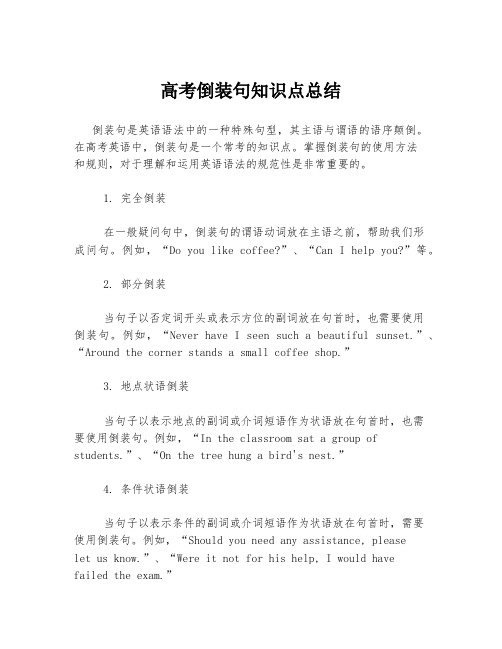
高考倒装句知识点总结倒装句是英语语法中的一种特殊句型,其主语与谓语的语序颠倒。
在高考英语中,倒装句是一个常考的知识点。
掌握倒装句的使用方法和规则,对于理解和运用英语语法的规范性是非常重要的。
1. 完全倒装在一般疑问句中,倒装句的谓语动词放在主语之前,帮助我们形成问句。
例如,“Do you like coffee?”、“Can I help you?”等。
2. 部分倒装当句子以否定词开头或表示方位的副词放在句首时,也需要使用倒装句。
例如,“Never have I seen such a beautiful sunset.”、“Around the corner stands a small coffee shop.”3. 地点状语倒装当句子以表示地点的副词或介词短语作为状语放在句首时,也需要使用倒装句。
例如,“In the classroom sat a group of students.”、“On the tree hung a bird's nest.”4. 条件状语倒装当句子以表示条件的副词或介词短语作为状语放在句首时,需要使用倒装句。
例如,“Should you need any assistance, pleaselet us know.”、“Were it not for his help, I would havefailed the exam.”5. 否定副词倒装在句子中用否定副词放在句首时,也需要使用倒装句。
例如,“Not only did she finish her homework, but she also tidiedup her room.”、“Seldom have I seen such a tale nted musician.”6. 句首状语从句倒装在句子的开头出现状语从句时,常常使用倒装句。
例如,“If only I could turn back time.”、“When I saw her, sobeautiful was she that I couldn't take my eyes off her.”总结起来,倒装句的使用规则主要包括完全倒装、部分倒装、地点状语倒装、条件状语倒装、否定副词倒装和句首状语从句倒装。
高中英语倒装句的语法知识点总结

高中英语倒装句的语法知识点总结在英语语法中,如果把位于动词放在在于前面,就叫倒装句。
关于英语倒装句的语法知识点你还了解多少?下面由店铺为大家提供关于高中英语倒装句的语法知识点总结,希望对大家有帮助!倒装句知识点一、讲解1.倒装句的定义:英语最基本的词序是主语在谓语动词的前面。
如果把谓语动词放在主语前面,就叫做倒装。
3. 倒装的原因a) 句子语法结构的需要。
例如:Did you attend the meeting? 你参加会议了吗?Long live peace! 和平万岁!b) 一些句型的固定用法。
例如:Such were his last words. 他最后的话就是这样。
c)强调的需要。
倒装以后,句子更加流畅生动。
例如:Never before have we seen such a sight. 以前我们从来没有见过这样的情景。
Before us lay a lot of difficulties. 在我们前面有很多困难。
Often did we warn them not to do so. 我们曾多次警告他们不要这样做。
4. 倒装句的基本用法a) 构成疑问句(除对主语或主语之定语提问的特殊疑问句外):When are we going to drink to your happiness? 我们什么时候喝你们的喜酒?Have you seen the film? 你看了那部电影吗?b) 在以here, there, now, then, in, away, up down等副词开头的句子中:Away went the crowd one by one. 人们一个一个地离去。
Here comes our teacher! 我们的老师来了!c) 副词only+状语放在句首时:Only then did he realize his mistakes . 只有在那时他才认识到自己的错误。
Only in this way can you learn maths well . 只有用这种方法你才能学好数学。
高中英语倒装句的归纳总结

高中英语倒装句的归纳总结倒装句是英语中的一种特殊语法结构,通常在句子中,主语和谓语动词的位置是固定的,即主语在前,谓语动词在后。
然而,在某些情况下,为了强调句子中的某个成分,或者为了满足特定的语法要求,我们需要将主语和谓语动词的位置颠倒,这就是倒装句。
倒装句在高中英语中经常出现,因此对其进行归纳总结具有重要的意义。
一、全部倒装全部倒装是指句子中的主语和谓语动词完全颠倒的情况,常见于以下几种情况:1. 在以副词here, there或者out, in等表示地点的副词开始的句子中,常常采用全部倒装。
Here comes the bus.(汽车来了。
)There goes the bell.(铃声响了。
)Out rushed the children.(孩子们冲了出去。
)2. 在以表示方向的副词和介词短语开头的句子中,常采用全部倒装。
Down went the sun.(太阳下山了。
)In came the teacher.(老师进来了。
)3. 在以表示否定意义的副词或副词短语开头的句子中,常采用全部倒装。
Never have I seen such a beautiful view.(我从未见过如此美景。
)Not only does he play basketball, but he also plays football.(他不仅打篮球,还踢足球。
)二、部分倒装部分倒装是指只将谓语动词和助动词或情态动词提到主语之前,而将其他成分保持原来顺序的情况。
常见的部分倒装有以下几种情况:1. 在以表示否定意义的副词或副词短语位于句首时,动词与主语之间采用部分倒装。
Never have I been to Paris.(我从未去过巴黎。
)Hardly had she finished her speech when they clapped.(她刚刚讲完演讲就被他们鼓掌了。
)2. 在以so和neither引导的倒装句中,动词与主语之间采用部分倒装。
(完整版)高中英语倒装句语法知识汇总

高中英语倒装句倒装句分为全部倒装和部分倒装1 全部倒装全部倒装是只将句子中的谓语动词全部置于主语之前。
此结构通常只用于一般现在时和一般过去时。
常见的结构有:1)here, there, now, then, thus等副词置于句首, 谓语动词常用be, come, go, lie, run等表示来去或状态的动词。
Then came the chairman. 那时总裁来了。
Here is your letter. 你的信。
2)表示运动方向的副词或地点状语置于句首,谓语表示运动的动词。
Out rushed a missile from under the bomber. 轰炸机肚底下窜出一枚导弹。
Ahead sat an old woman. 前面坐着一个老妪。
注意:上述全部倒装的句型结构的主语必须是名词,如果主语是人称代词则不能完全倒装。
Here he comes. 他来了。
Away they went. 他们走开了。
2 部分倒装部分倒装是指将谓语的一部分如助动词或情态倒装至主语之前。
如果句子的谓语没有助动词或情态动词,则需添加助动词do, does或did,并将其置于主语之前。
1.句首为否定或半否定的词语,如no, not, never, seldom, little, hardly, at no time决不, in no way, not until…等。
Never have I seen such a performance. 从未见过如此糟糕的表演。
Nowhere will you find the answer to this question. 无论如何你不会找到这个问题的答案的。
Not until the child fell asleep did the mother leave the room. 母亲一直到孩子入睡后离开房间。
2.当Not until引出主从复合句,主句倒装,从句不倒装。
高中英语知识点归纳倒装句的用法总结

高中英语知识点归纳倒装句的用法总结高中英语知识点归纳:倒装句的用法总结倒装句是英语语法中的一种特殊语法结构,常见于各种语言形式中。
倒装句通常在句子中,把谓语动词放在主语之前,从而改变了正常语序。
在英语学习中,倒装句是一个重要的知识点,掌握了它的基本用法,可以使我们的表达更加地准确、得体。
本文将对高中英语学习中与倒装句有关的知识进行归纳和总结,以便同学们更好地掌握和运用。
一、完全倒装句完全倒装句是指把整个谓语动词放在主语之前,常用于以下几种情况:1.以副词或介词词组开头的句子:- Never have I seen such a beautiful sunset. 我从未见过如此美丽的日落。
- In front of us stood a tall building. 在我们面前矗立着一座高楼。
2.以表示否定意义的副词开头的句子:- Not only did she forget my birthday, but she also didn't apologize. 她不仅忘记了我的生日,而且也没有道歉。
3.以表示“只有、仅仅、唯一”等意义的副词或词组开头的句子:- Only by working hard can you achieve your goals. 只有通过努力工作,你才能实现自己的目标。
4.以表地点的副词或介词短语放在句首,句子的主语为there时:- There is a cat under the table. 桌子下有一只猫。
- Here comes the train. 火车来了。
二、部分倒装句部分倒装句是指把助动词放在主语之前,常用于以下几种情况:1.以表示否定的词或短语开头的句子,包括never、not、seldom、hardly等:- Never have I seen such a talented musician. 我从未见过如此有天赋的音乐家。
2.以表示“只有、仅仅、唯一”等意义的副词或词组开头的句子,包括only、hardly等:- Only when the sun sets can we see the stars in the sky. 只有太阳下山后,我们才能看到天空中的星星。
高考英语倒装句知识点总结

高考英语倒装句知识点总结在高考英语中,倒装句是一个常见但容易出错且易混淆的语法知识点。
在理解和运用倒装句时,我们需要掌握一些关键规则和特殊情况。
本文将系统总结常见的高考英语倒装句知识点,帮助考生更好地应对这一考点。
一、完全倒装完全倒装是指将助动词、情态动词、系动词、动词原形或短语放在主语前。
常见的情况有以下几种:1. 情态动词+主语+其他。
例如:Can he swim?(他会游泳吗?)2. 出现否定词,如never,not,nor等。
例如:Never have I seen such a beautiful sunset.(我从未见过如此美丽的日落。
)3. Only引导的倒装句。
例如:Only when you face your fears can you overcome them.(只有当你面对恐惧时,你才能克服它们。
)二、部分倒装部分倒装是指将助动词、情态动词或系动词放在主语前,而动词原形放在主语后。
常见的情况有以下几种:1. 祈使句倒装。
例如:Open the window, please.(请打开窗户。
)2. So引导的倒装句。
例如:He was late for the meeting, so was I.(他迟到了会议,我也是。
)3. 强调句倒装。
例如:It was in Paris that I met my true love.(我在巴黎遇到了我的真爱。
)三、介词短语倒装在以介词短语开头的句子中,常常用倒装结构来强调一些信息。
例如:Out of the classroom ran the excited children.(兴奋的孩子们跑出了教室。
)四、条件句倒装在条件句中,如果主句表达的是命令、建议、要求或愿望,那么条件句中即使是虚拟语气的情况下,也要采用部分倒装。
例如:Should you need any assistance, please feel free to contact us.(如果你需要任何帮助,请随时联系我们。
高中英语知识点归纳倒装句的用法

高中英语知识点归纳倒装句的用法倒装句是英语中的一种常见语法现象,它与一般的语序有所不同。
在倒装句中,谓语动词不再位于句子的中间,而是移到主语之前或状语之前,这种语法结构的运用可以使句子显得更加生动有趣。
下面将对高中英语中常见的倒装句进行归纳总结。
一、完全倒装句完全倒装句是指将助动词、情态动词或系动词放在主语之前,句子的谓语动词则位于主语之后。
完全倒装句的结构为:助动词/情态动词/系动词+主语+谓语动词+其他。
1.助动词完全倒装句助动词包括be动词、have动词和do动词。
当句子以副词here、there或表示方向的副词(如up、down、in、out等)开头时,为了突出地点或方向,可以采用助动词完全倒装的形式。
例如:Here comes the bus.There is a cat under the table.Down came the rain.2.情态动词完全倒装句情态动词包括can、could、may、might、must、shall、should、will、would等。
在表示祝愿、建议、命令等意义时,可以采用完全倒装的形式。
例如:May you have a happy birthday!Should you need any help, feel free to ask.Will you please close the door?3.系动词完全倒装句系动词包括be动词、seem、appear、look、sound等。
在表示位置、方式、状态、主语特征等方面时,可以采用系动词完全倒装的形式。
例如:On the table lies a book.How beautiful the flowers are!Tired as he was, he kept working.二、部分倒装句部分倒装句是指将谓语动词的一部分(通常是助动词或情态动词)与主语之间的位置对调,这种语法结构常见于否定句、选择疑问句和以感叹词开头的句子。
高考英语倒装句最全总结
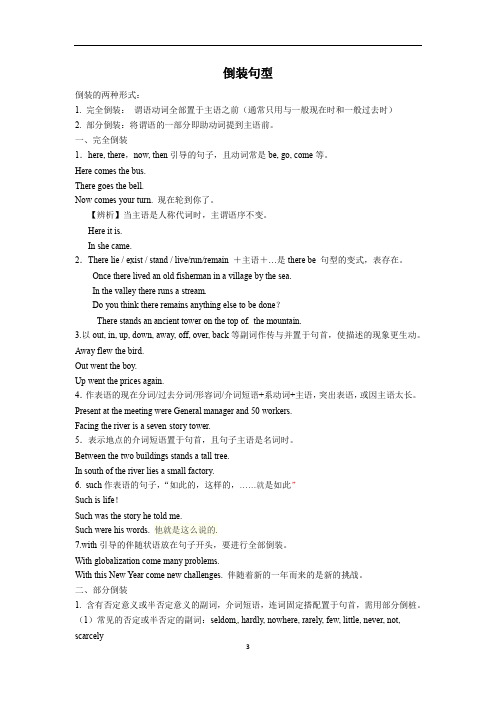
倒装句型倒装的两种形式:1. 完全倒装:谓语动词全部置于主语之前(通常只用与一般现在时和一般过去时)2. 部分倒装:将谓语的一部分即助动词提到主语前。
一、完全倒装1.here, there,now, then引导的句子,且动词常是be, go, come等。
Here comes the bus.There goes the bell.Now comes your turn. 现在轮到你了。
【辨析】当主语是人称代词时,主谓语序不变。
Here it is.In she came.2.There lie / exist / stand / live/run/remain +主语+…是there be 句型的变式,表存在。
Once there lived an old fisherman in a village by the sea.In the valley there runs a stream.Do you think there remains anything else to be done?There stands an ancient tower on the top of the mountain.3.以out, in, up, down, away, off, over, back等副词作传与并置于句首,使描述的现象更生动。
Away flew the bird.Out went the boy.Up went the prices again.4.作表语的现在分词/过去分词/形容词/介词短语+系动词+主语,突出表语,或因主语太长。
Present at the meeting were General manager and 50 workers.Facing the river is a seven-story tower.5.表示地点的介词短语置于句首,且句子主语是名词时。
Between the two buildings stands a tall tree.In south of the river lies a small factory.6.such作表语的句子,“如此的,这样的,……就是如此”Such is life!Such was the story he told me.Such were his words. 他就是这么说的.7.with引导的伴随状语放在句子开头,要进行全部倒装。
高中英语知识点归纳倒装句的分类与使用技巧

高中英语知识点归纳倒装句的分类与使用技巧高中英语知识点归纳:倒装句的分类与使用技巧倒装句是英语语法中的一种特殊结构,通常将助动词、情态动词或be动词置于句首,而将主语放在谓语动词之后。
本文将对高中英语中的倒装句进行分类并介绍其使用技巧。
一、完全倒装句完全倒装句是指将句子的全部谓语动词置于主语之前,通常用于以下三种情况:1. 当以表示地点的副词或介词短语开头时,如:Here comes the bus.(汽车来了。
)2. 当以表示方向的副词或介词短语开头时,如:Out rushed the children.(孩子们冲了出去。
)3. 当以表示否定意义的副词或介词短语开头时,如:Never have I seen such a beautiful sunset.(我从未见过如此美丽的日落。
)二、部分倒装句部分倒装句是指将助动词、情态动词或be动词置于句首,而将主语和谓语动词继续保持原来的位置。
部分倒装句常见于以下几种情况:1. 某些表示习惯、偏好、意愿、建议的动词后,如:I would rather you came early.(我宁愿你早点来。
)2. 在表语从句中,如:What she needs is not money, but love.(她需要的不是金钱,而是爱。
)3. 在条件状语从句或时间状语从句中,如:Should you have any questions, feel free to ask.(如果你有任何问题,请随时提问。
)4. 在虚拟条件句中,如:Had I known earlier, I would have helped.(要是我早知道,我会帮忙的。
)三、倒装句的使用技巧1. 在虚拟语气中,常用部分倒装句来表达与事实相反的假设,如:Were it not for your help, I would have failed.(要不是你的帮助,我就会失败。
)2. 当表示时间或地点的副词放于句首时,采用完全倒装句,如:In front of me stood a majestic mountain.(在我面前矗立着一座雄伟的山峰。
高中 英语 倒装句用法归纳
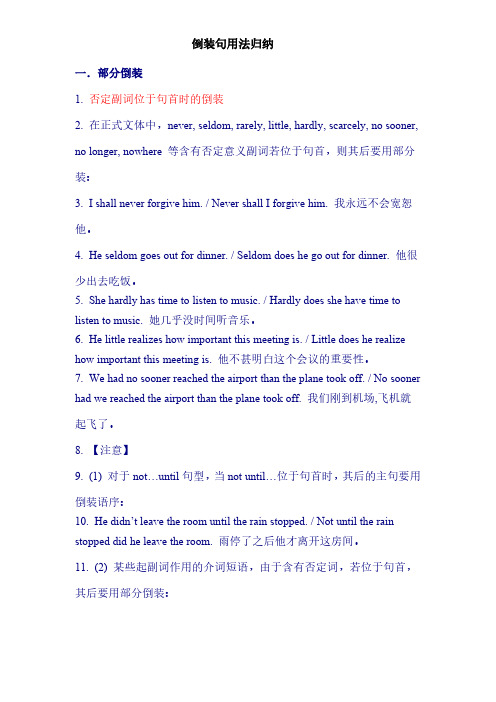
一.部分倒装1.否定副词位于句首时的倒装2.在正式文体中,never,seldom,rarely,little,hardly,scarcely,no sooner, no longer,nowhere等含有否定意义副词若位于句首,则其后要用部分装:3.I shall never forgive him./Never shall I forgive him.我永远不会宽恕他。
4.He seldom goes out for dinner./Seldom does he go out for dinner.他很少出去吃饭。
5.She hardly has time to listen to music./Hardly does she have time to listen to music.她几乎没时间听音乐。
6.He little realizes how important this meeting is./Little does he realize how important this meeting is.他不甚明白这个会议的重要性。
7.We had no sooner reached the airport than the plane took off./No sooner had we reached the airport than the plane took off.我们刚到机场,飞机就起飞了。
8.【注意】9.(1)对于not…until句型,当not until…位于句首时,其后的主句要用倒装语序:10.He didn’t leave the room until the rain stopped./Not until the rain stopped did he leave the room.雨停了之后他才离开这房间。
11.(2)某些起副词作用的介词短语,由于含有否定词,若位于句首,其后要用部分倒装:12.On no accounts must this switch be touched.这个开关是绝不能触摸的。
倒装句的总结大全

高中英语倒装句语法知识汇总一.概念:英语句子通常有两种语序:一种主语在前,谓语在后,称为自然语序,另一种谓语在前,主语在后,称为倒装语序。
二.相关知识点精讲按“主语+ 谓语”这种顺序排列的句子是陈述语序。
如果排列顺序变为“谓语(或谓语一部分)+主语”,就是倒装。
倒装句分为:完全倒装:整个谓语移至主语前面叫完全倒装。
部分倒装:只把助动词、系动词或情态动词放在主语之前叫部分倒装。
1. 当以there, here, out , in , up , down, away 等副词开头的句子,为了起到强调的作用,可构成倒装句,只把副词放在句首,主语和谓语位置调换,不加助动词。
Our teacher came in. In came our teacher.这种倒装要求:主语必须是名词。
主语是人称代词时,主语和谓语语序不变。
Here it is. Away he went.这类倒装句式一般只用一般现在时和一般过去时。
Here comes the bus. Out rushed the boys.w, then, just, often 表示时间的副词放在句首,可构成倒装句,只把副词放句首,主语和谓语位置调换,不加助动词。
Then came 8 years of the Anti Japanese War.3. 表地点状语的介词短语放在句首,要用倒装句式,以示强调。
这种倒装句也是主谓直接调换位置,不加助动词did, does或do.Under a big tree ________, half asleep.A. did sat a fat manB. a fat man satC. did a fat man satD. sat a fat man4. there放在句首时,要用倒装句式。
在“there + be”结构中的谓语动词有时不用be , 而用表示类似“存在”观念的其他不及物动词。
如:live, stand, come, lie, flow, enter, rise 和appear等。
(完整版)高中英语语法倒装总结全
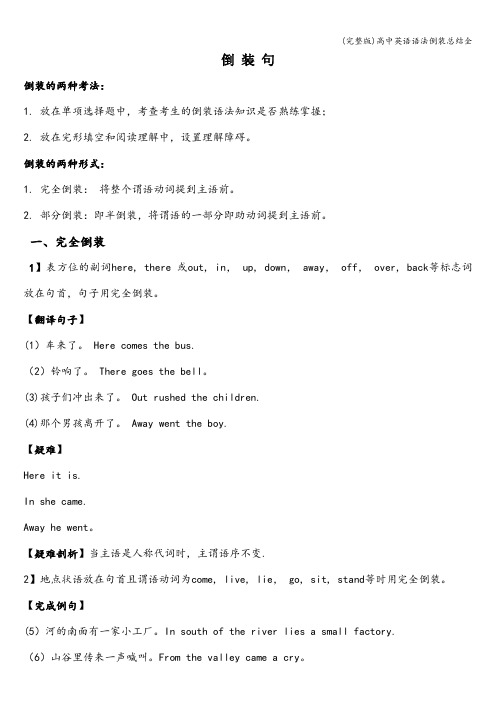
倒装句倒装的两种考法:1. 放在单项选择题中,考查考生的倒装语法知识是否熟练掌握;2. 放在完形填空和阅读理解中,设置理解障碍。
倒装的两种形式:1. 完全倒装:将整个谓语动词提到主语前。
2. 部分倒装:即半倒装,将谓语的一部分即助动词提到主语前。
一、完全倒装1】表方位的副词here, there 或out, in, up, down, away, off, over, back等标志词放在句首,句子用完全倒装。
【翻译句子】(1)车来了。
Here comes the bus.(2)铃响了。
There goes the bell。
(3)孩子们冲出来了。
Out rushed the children.(4)那个男孩离开了。
Away went the boy.【疑难】Here it is.In she came.Away he went。
【疑难剖析】当主语是人称代词时,主谓语序不变.2】地点状语放在句首且谓语动词为come, live, lie, go, sit, stand等时用完全倒装。
【完成例句】(5)河的南面有一家小工厂。
In south of the river lies a small factory.(6)山谷里传来一声喊叫。
From the valley came a cry。
3】 such, the following等放句首时,句子要完全倒装。
【翻译句子】(7)Such are the facts. 情况就是如此。
(8)生活就是这样。
Such is life.(9)The following is the answer to the question。
这个问题的答案如下。
4】There lie / exist / stand / live +主语+…是there be 句型的变式【翻译句子】(10)山顶上有一幢高楼.There is a tall building on the top of the mountain.(11)山顶上耸立着一座古塔。
高中英语知识点归纳倒装句的用法和情况

高中英语知识点归纳倒装句的用法和情况高中英语知识点归纳:倒装句的用法和情况倒装句是英语语法中的一种特殊句型,与正常的语序(主语+谓语+宾语)相比,其主谓顺序颠倒,即谓语动词或助动词位于主语之前。
倒装句在不同的语境下有不同的用法和情况。
本文将归纳总结高中英语中常见的倒装句用法和情况,帮助同学们更好地理解和运用倒装句。
一、全部倒装句全部倒装句是指将整个谓语动词短语进行倒装。
以下几种情况常见于高中英语教材和考试中:1. 否定词位于句首在句首的否定词有:never, seldom, rarely, little, hardly, scarcely等。
句子中主语与谓语动词间需要加助动词do的倒装形式。
例句:Never have I seen such a beautiful sunset.Seldom does he come to visit his grandparents.2. 表示地点、方向或方式的状语位于句首当表示地点、方向或方式的状语置于句首时,主谓语序需要颠倒。
例句:Up the hill ran the children happily.In front of the mirror stood the beautiful girl.3. “Only+状语”位于句首当“only+状语”出现在句首时,需要对主谓语序进行倒装。
例句:Only by working hard can you achieve your goals.Only in this way can we solve the problem.二、部分倒装句部分倒装句是指将助动词或情态动词与主语之间的顺序颠倒。
以下是常见的部分倒装句情况:1. 条件状语从句中的倒装在以“should”开头的虚拟条件状语从句和“had”开头的虚拟条件状语从句中,助动词或情态动词应置于主语之前。
例句:Should it rain tomorrow, we will stay at home.Had I known the truth earlier, I would have made a different decision.2. so/such+形容词/副词+单数可数名词+that从句当so/such引导的句子中形容词/副词修饰名词或整个句子时,助动词或情态动词需要与主语倒装。
高中英语倒装句语法知识点
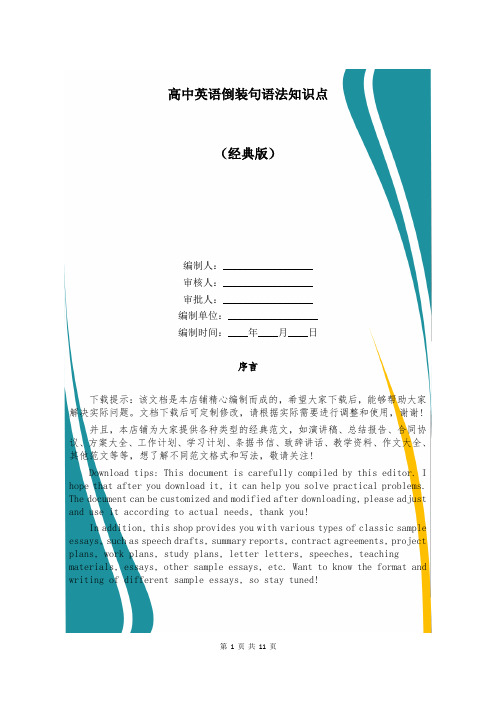
高中英语倒装句语法知识点(经典版)编制人:__________________审核人:__________________审批人:__________________编制单位:__________________编制时间:____年____月____日序言下载提示:该文档是本店铺精心编制而成的,希望大家下载后,能够帮助大家解决实际问题。
文档下载后可定制修改,请根据实际需要进行调整和使用,谢谢!并且,本店铺为大家提供各种类型的经典范文,如演讲稿、总结报告、合同协议、方案大全、工作计划、学习计划、条据书信、致辞讲话、教学资料、作文大全、其他范文等等,想了解不同范文格式和写法,敬请关注!Download tips: This document is carefully compiled by this editor. I hope that after you download it, it can help you solve practical problems. The document can be customized and modified after downloading, please adjust and use it according to actual needs, thank you!In addition, this shop provides you with various types of classic sample essays, such as speech drafts, summary reports, contract agreements, project plans, work plans, study plans, letter letters, speeches, teaching materials, essays, other sample essays, etc. Want to know the format and writing of different sample essays, so stay tuned!高中英语倒装句语法知识点英语最基本的词序是主语在谓语动词的前面。
高中英语知识点归纳倒装句

高中英语知识点归纳倒装句倒装句是英语语法中的一个重要概念,常常用于强调句子的某个部分或为了实现语法需求。
在高中英语学习过程中,倒装句是必须掌握的一种语法结构。
本文将对倒装句的知识点进行归纳总结,包括倒装语序的基本形式、用途以及一些常见的倒装句类型。
1. 完全倒装在完全倒装中,整个谓语动词位于主语之前,用以强调句子中其他成分。
a. 当句子以副词或短语开头时,通常会使用完全倒装。
例如:- Never have I seen such a beautiful sunset.- In no way could he understand the meaning of the poem.b. 当表示地点或时间的介词短语放在句首时,常常使用完全倒装。
例如:- On the top of the mountain stood a small cottage.- At the end of the corridor hangs a famous painting.c. 当表示“here”、“there”或“out”放在句首时,也会使用完全倒装。
例如:- Here comes the bus!- There goes the bell!2. 部分倒装部分倒装是指将助动词或情态动词与主语之间调换位置,或者将系动词与主语之间调换位置。
它通常用于祈使句、虚拟条件句、以"neither/nor"或"either/or"引导的倒装句等。
a. 在以“May/Can/Will/Should等情态动词”引导的祈使句中,部分倒装会出现。
例如:- May you have a wonderful journey!- Can you please pass me the salt?b. 在虚拟条件句中,当条件句以"had"或"should"开头时,常常使用部分倒装。
高中英语语法专题复习倒装句
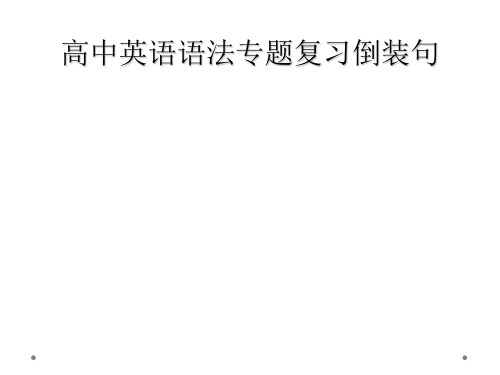
知识详解
部分倒装
9、用于某些表示祝愿的句子中。如: Long live the Chinese Communist Party.
跟踪练习
1.Scarcely _______ asleep _______ a knock at the door awakened him.
A. she had fallen; when B. she had fallen; than C. had she fallen; than D. had she fallen; when
Inside the pyramids are the burial rooms for the kings and queens and long passages to these rooms.
强调作用
They arrived at a farmhouse, in front which sat a small boy.
跟踪练习
9. ______ can you expect to get a rise. A. With hard work B. Although work hard C. Only with hard work D. Now that he works hard
10. _____ she wondered if she had made a mistake. A. Not until long afterwards that B. It was not until long afterwards that C. Not long until afterwards D. It was long afterwards until
知识详解
完全倒装
2、用于“here (there, now, then) + 不及物动词 +主语 (名词)”的句型中,或以out, in up down, away 等 副词开头的句子,以表示强调。如:
高三英语倒装句知识点
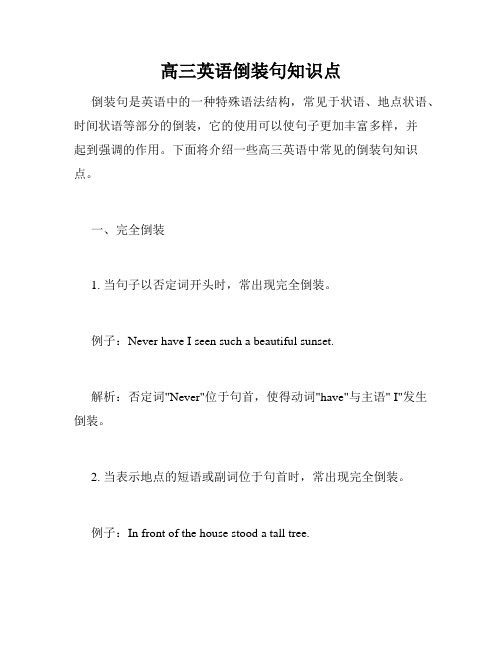
高三英语倒装句知识点倒装句是英语中的一种特殊语法结构,常见于状语、地点状语、时间状语等部分的倒装,它的使用可以使句子更加丰富多样,并起到强调的作用。
下面将介绍一些高三英语中常见的倒装句知识点。
一、完全倒装1. 当句子以否定词开头时,常出现完全倒装。
例子:Never have I seen such a beautiful sunset.解析:否定词"Never"位于句首,使得动词"have"与主语" I"发生倒装。
2. 当表示地点的短语或副词位于句首时,常出现完全倒装。
例子:In front of the house stood a tall tree.解析:地点短语"In front of the house"位于句首,使得动词"stood"与主语" a tall tree"发生倒装。
3. 当表示方向的副词放在句首时,常使用完全倒装。
例子:Down the street ran the little boy.解析:副词"Down"置于句首,使得动词"ran"与主语" the little boy"发生倒装。
二、部分倒装1. 当句子以表示否定的副词或短语开头时,常出现部分倒装。
例子:Not only did she pass the exam, but she also got the highest score.解析:否定副词"Not only"位于句首,使得助动词"did"与主语"she"发生倒装。
2. 当使用含有比较级的状语从句时,常出现部分倒装。
例子:The harder you work, the more progress you will make.解析:状语从句"the harder you work"中的主谓发生倒装。
- 1、下载文档前请自行甄别文档内容的完整性,平台不提供额外的编辑、内容补充、找答案等附加服务。
- 2、"仅部分预览"的文档,不可在线预览部分如存在完整性等问题,可反馈申请退款(可完整预览的文档不适用该条件!)。
- 3、如文档侵犯您的权益,请联系客服反馈,我们会尽快为您处理(人工客服工作时间:9:00-18:30)。
注意:(1)如果前句的谓语动词是实义动词,倒装结构中用助动词do,does或did;如果前句的谓语中含有be动词、助动词或情态动词,倒装结构中则要根据其主语使用相应的动词。例如:
He can do it, and so can I. 他能做到,我也能做到。
他们来到一个小村庄,村庄前面是条大河.
2部分倒装
a. 否定副词位于句首时的倒装
在正式文体中,never, seldom,rarely, little, hardly, scarcely, no sooner, no longer, nowhere 等含有否定意义的副词若位于句首,则其后要用部分倒装:
【注意】
(1) 对于not…until句型,当not until…位于句首时,其后的主句要用倒装语序:
He didn’t leave the roomuntil the rain stopped. / Not until the rain stoppeddid he leave the room. 雨停了之后他才离开这房间。
但是,in no time(立即,马上)位于句首时,其后无需用倒装语序:
In no time he worked out the problem. 他马上就算出了那道题。
b.“only+状语”位于句首时的倒装
当一个状语受副词only的修饰且置于句首时,其后用部分倒装语序:
Only then did he realize that he was wrong. 到那时他才意识到他错了。
一、倒装句的定义
主语和谓语是句子的核心,它们之间有两种语序:一是主语在谓语之前称为自然语序(Natural Order)/陈述语序;二是主语在谓语之后则称为倒装语序(Inverted Order)。为了强调、突出等语的目的而颠倒原有语序的句式叫做倒装句。在倒装句中,颠倒了的成分可以恢复原位而句意基本不变,句法成分不变。
Mr Li, Mr Wang and many other teacherswere presentat the meeting
出席会议的有李老师、王老师和其他很多老师.
(2 )过去分词+连系动词+主语
Gone are the days when we used foreign oil.
The dayswhen we used foreign oilare gone.
He little realizes how important this meeting is. /Littledoes he realize how important this meeting is. 他不甚明白这个会议的重要性。
We had no sooner reached the airport than the plane took off. / No sooner had we reached the airport than the plane took off. 我们刚到机场,飞机就起飞了。
注意:
(1 )主语是代词时,主语和谓语不倒装.
(2 ) here , there 放在句首通常用一般现在时.There comes the bus.
c. 当句首状语为表示地点的介词词组.
d. 表语置于句首时,倒装结构为“表语+连系动词+主语”:
(1 )形容词+连系动词+主语
Present at the meeting were Mr Li, Mr Wang and many other teachers.
Is Lily singing or dancing? 莉莉是在唱歌还是在跳舞?
What does your mother do? 你妈妈是干什么的?
d.在以so开头的句子中,使用倒装句式可以使所表达的意思更趋简洁,其汉语意思为“也”。例如:He can ride a bike, and so can I. 他会骑自行车,我也会。
Only in this way are you able to do it well. 你只有用这种方法才能把它做好。
Only when he returned home did he realize what had happened. 当他回到家里时,才知道出了什么事。
c. 在一般疑问句和特殊疑问句中常用倒装句。例如:
Ishallneverforgivehim./Nevershall I forgive him. 我永远不会宽恕他。
He seldom goes out for dinner./Seldomdoes he go out for dinner. 他很少出去吃饭。
She hardly has time to listen to music. / Hardly does she have time to listen to music. 她几乎没时间听音乐。
Youareagoodstudent.他也是。
你不会说法语,她也不会.
f. 为了保持句子平衡,或为了强调表语或状语,或是上下文紧密衔接时.
例如:They arrived at a small village, in front of which was a big river.
Theyarrivedatasmall village. A big river was in front of it.
The days are gonewhen we used foreign oil.
我们使用洋油的日子一去不复返了.
(3 )介词短语+ be +主语
Among the goods are books, exercise-books, pens and some other things.
在所有的货物中有书、练习册、钢笔和其他东西.
(2) 某些起副词作用的介词短语,由于含有否定词,若位于句首,其后要用部分倒装:
On no accountsmust this switch be touched. 这个开关是绝不能触摸的。
In [Under] no circumstanceswill I lend money to him.无论如何我也不会再借钱给他了。
He is working hard, and so are we. 他在努力工作,我们也在努力工作。
(2)有时so可以表示对前句内容的进一步肯定,意思相当于“是的;的确如此”,此时不可使用倒装结构。例如:
—They will have a good time this evening. 他们今晚会玩得很愉快。
中文例子:
还行吧这样
可以吧我觉得
我认识他好像
想啥呢刚才
吃饭了嘛你
可以的他
倒装句可分为全部倒装和部分倒装两种:
1、全部倒装
谓语动词提前至主语之前为全部倒装。
a.用于 there be 句型.There is a buscoming
b. 用于“ here ( there, now, then )+不及物动词+主语”的句型中,或以 in, out, up, down, away 等副词开头的句子里,以表示强调.
—So they will. 的确此。
—It’s fine today, isn’t it? 今天天气不错,是吗?
—Ah, so it is. 啊!的确如此。
连词as引导让步状语从句时,从句需采用倒装结构,这时往往把动词、形容词、名词、副词或分词提到主语之前。结构为:名词(不加冠词)/形容词/副词/动词/分词+ as +主语+谓语。例如:
Young as he is, he knows a lot. 尽管他很年轻,但是他知道很多。
As he is young, he knows a lot.
Surrounded as we were by the enemy, we managed to fight our way out. 尽管被敌人包围了,我们还是设法冲了出来。
e. 用于 so, neither , nor 开头的句子,表示重复前句的部分内容.原句的谓语应与前句的谓语的时态、形式相一致.
例如:You can'tspeak French.Neither can she.
She can’t speak French neither. Neither can shespeak French.
